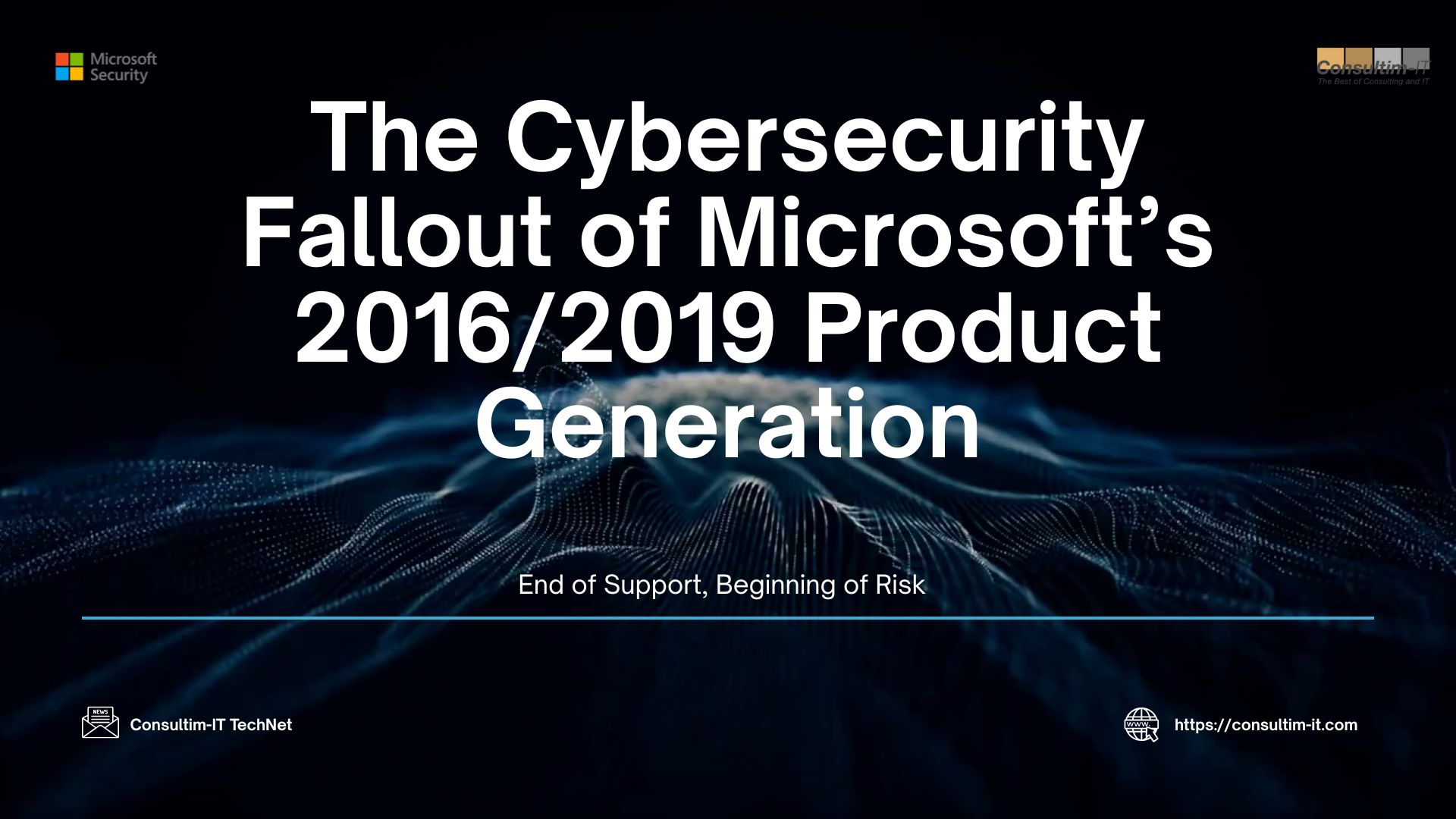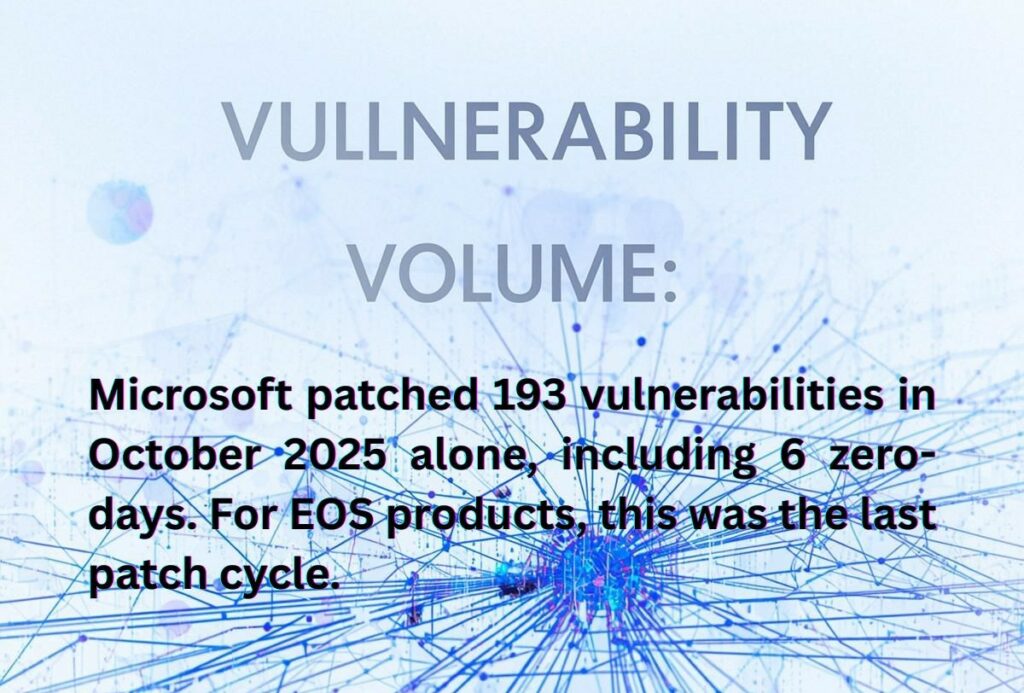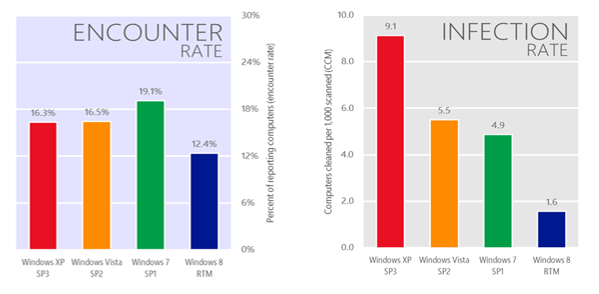Migration Path: Upgrade to Windows 11 / Windows 365
Contact
business@consultim-it.comPhone
+216 53 32 95 13ㅤㅤㅤㅤThe Cybersecurity Fallout of Microsoft’s 2016/2019 Product Generation

End of Support, Beginning of Risk: The Cybersecurity Fallout of Microsoft’s 2016/2019 Product Generation
By Iheb zannina Cybersecurity Advisory Team
October 14, 2025 A Turning Point in Enterprise Security
On October 14, 2025, Microsoft officially ended support for a wide range of cornerstone products: Windows 10, Office 2016/2019, Exchange Server 2016/2019, Skype for Business 2016/2019, Visio and Project 2016/2019, and Visual Studio 2015/2019. SharePoint Server 2019 will follow on July 14, 2026.
For many organizations, this date was more than a licensing milestone, it marked the transition of millions of devices and workloads into a high-risk state. Unsupported software is no longer patched against newly discovered vulnerabilities, leaving enterprises exposed to an ever-expanding threat landscape.
This article explores the cybersecurity implications of this end-of-support (EOS) wave, the attack vectors most likely to be exploited, and the strategic actions organizations must take to mitigate risk.
Over 200 million PCs worldwide cannot upgrade to Windows 11 due to hardware restrictions, meaning they’ll be stuck on Windows 10 after end-of-support.
Why End of Support Equals Cyber Risk
When Microsoft ends support for a product, three things happen simultaneously:
- No More Security Updates
- Newly discovered vulnerabilities remain unpatched.
- Attackers can weaponize exploits indefinitely, knowing defenders have no vendor-issued fixes.
- Loss of Compliance
- Frameworks like ISO 27001, HIPAA, PCI-DSS, and GDPR require supported software.
- Running EOS systems can trigger audit failures and regulatory penalties.
- Increased Exploitability
- Attackers actively scan for outdated systems.
- Exploit kits and ransomware groups specifically target legacy environments.
The October 2025 Patch Tuesday underscored this reality: Microsoft patched over 193 vulnerabilities, including multiple zero-days under active exploitation 1 2. For Windows 10 and Office 2019, this was the final patch cycle. Every vulnerability disclosed after this date is now a permanent risk for organizations that fail to migrate.

High-Value Targets: Where Attackers Will Strike First
1. Windows 10 Endpoints
- Still deployed on hundreds of millions of devices worldwide 3.
- Legacy hardware unable to upgrade to Windows 11 creates a massive pool of unprotected endpoints.
- Attackers will exploit kernel-level privilege escalation flaws and lateral movement opportunities.
2. Exchange Server 2016/2019
- Historically one of the most exploited Microsoft products (e.g., ProxyLogon and ProxyShell).
- EOS means no more patches for remote code execution flaws in OWA and EWS.
- On-prem Exchange servers will become prime ransomware entry points.
3. Office 2016/2019
- Macros remain a top malware delivery vector.
- Unsupported Office apps won’t receive mitigations against new phishing and document-based exploits.
- Attackers can bypass defenses by targeting outdated Office installations.
4. Skype for Business 2016/2019
- Legacy VoIP and messaging platforms are often overlooked in patching strategies.
- EOS creates opportunities for man-in-the-middle attacks and credential harvesting.
5. SharePoint Server 2016/2019
- Although SharePoint 2019 has a brief reprieve until July 2026, attackers will exploit unpatched web application vulnerabilities.
- Misconfigured SharePoint farms are already a common target for web shell deployments.
Studies show that 60% of breaches exploit unpatched or unsupported software
The Cybersecurity Impact in Numbers
- 193 vulnerabilities patched in Microsoft’s October 2025 release 1.
- Six zero-days, four of which were already being exploited in the wild 1.
- After EOS, every new CVE disclosed becomes a permanent exploit path for Windows 10, Office 2016/2019, and Exchange 2016/2019.
- Industry analysts estimate 200+ million PCs cannot upgrade to Windows 11 due to hardware restrictions 3, a massive, unmanaged attack surface.

Attack Scenarios in the Post-EOS Era
Ransomware via Legacy Exchange
- Attacker exploits an unpatched RCE in Exchange 2019.
- Gains domain admin privileges through credential dumping.
- Deploys ransomware across Windows 10 endpoints.
- Business impact: full operational shutdown, data exfiltration, regulatory fines.
Phishing with Unsupported Office
- User opens a malicious Excel file on Office 2016.
- Exploit bypasses outdated macro protections.
- Malware establishes persistence and exfiltrates credentials.
- Business impact: compromised M365 tenant, lateral movement into cloud workloads.
Shadow IT Risk
- Department continues using unsupported Visio 2016 for critical workflows.
- Vulnerability in rendering engine exploited via malicious diagram file.
- Attackers pivot into corporate network.
- Business impact: breach through overlooked “non-critical” software.
Migration Priority Roadmap
Cybersecurity Playbook for EOS
Strategic Response
Select Migration Priority Roadmap for details →
Migration Path: Move to Microsoft 365 Apps
Migration Path: Migrate to Exchange Online
Migration Path: Transition to Microsoft Teams
Migration Path: Migrate to SharePoint Online
Migration Path: Plan migration before deadline
Migration Path: Upgrade to Visual Studio 2022
Turning Risk into Opportunity
At Consultim-IT, we view the October 2025 EOS milestone not just as a risk event, but as an opportunity for modernization. Organizations that act decisively can:
- Reduce attack surface by eliminating legacy systems.
- Strengthen compliance posture with supported platforms.
- Adopt modern security models like Zero Trust and XDR.
- Optimize costs by consolidating workloads into Microsoft 365 and Azure.
Our advisory and technical teams are already helping clients assess EOS exposure, prioritize migrations, and deploy Microsoft’s security stack to safeguard hybrid environments.
How Consultim‑IT Can Help
At Consultim‑IT, we don’t just highlight the risks—we help you solve them. As a Microsoft Partner, we provide:
Seamless Upgrades & Migrations We guide you through upgrading from end‑of‑support products to modern Microsoft solutions such as Windows 11, Microsoft 365 Apps, Exchange Online, and SharePoint Online.
Licensing Expertise Our team ensures you have the right licensing model for your business needs, optimizing both cost and compliance.
Cybersecurity Reinforcement With our dedicated cybersecurity team, we secure your Microsoft ecosystem end‑to‑end, leveraging Microsoft Defender, Entra ID, Sentinel, and Zero Trust strategies to protect against evolving threats.
Strategic Advisory We align technology upgrades with your business goals, ensuring modernization strengthens both security posture and operational efficiency.
The end of support for Microsoft’s 2016/2019 generation is not just a deadline, it’s an opportunity. With Consultim‑IT as your partner, you can modernize, secure, and future‑proof your digital workplace.

